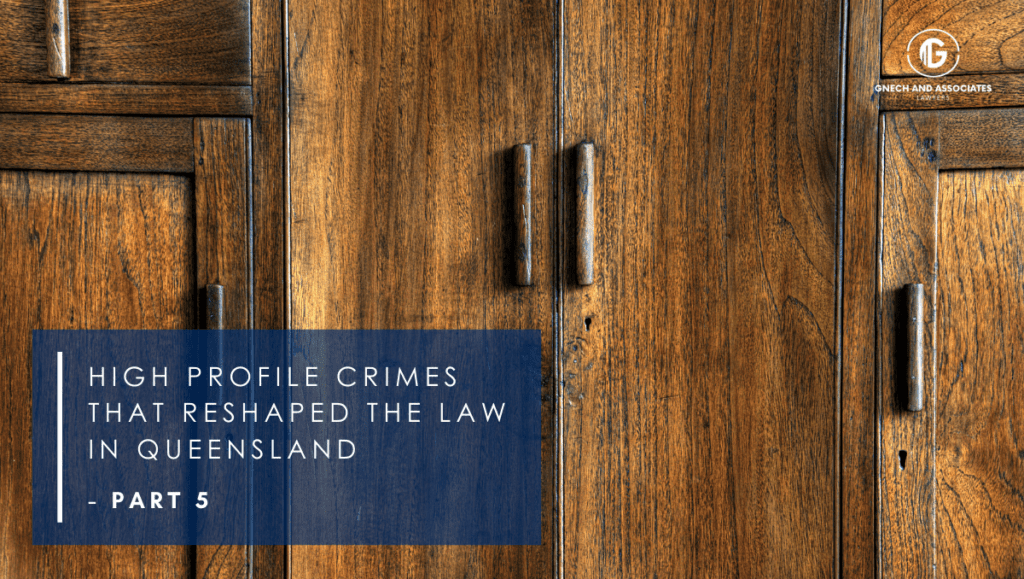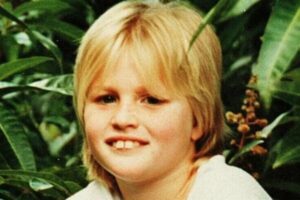The Girl in the Cupboard – Leonard Fraser

By Calvin Gnech, Criminal Lawyer and Legal Practice Director at Gnech and Associates
23 December 2021
In April 1999, schoolgirl Keyra Steinhardt was bashed, raped and murdered in a brazen daylight attack as she walked home form school in the central Queensland town of Rockhampton. The disappearance of Keyra made international headlines as the community and law enforcement officers searched for the nine year old.
When her killer, Leonard Fraser, finally led them to her body two weeks later, it was the catalyst that went on to expose him as a murderous sexual predator whose criminal career spanned three decades.
In September 2000 he was jailed for life for the abduction, rape and murder of Keyra.

Taskforce Alex
After a complex Queensland police investigation by Taskforce Alex, Fraser was charged with the murders of teenager Natasha Ryan, Julie Turner, Beverley Leggo and Sylvia Benedetti who all disappeared from the Rockhampton area between September 1998 and April 1999.
Secrets of a Cellmate
Part of the evidence used against him at trial was the taped conversations and maps secretly collected by Fraser’s cellmate Alan Quinn, a convicted conman turned police informant. Quinn also convinced Fraser to lead police to the remains of Ms Leggo and Turner. The murder of Keyra Steinhardt was also introduced into evidence. (Ms Bendetti’s remains were previously discovered by a member of the public walking through bushland behind a resort at Yeppoon.)
In 2003 he was found guilty of the murders of Ms Leggo and Ms Benedetti, and guilty of the manslaughter of Ms Turner. During his Supreme Court trial, one of his supposed murder victims, teenager Natasha Ryan, was discovered alive and well in a cupboard. She had been hiding out with her boyfriend.
Convictions
On 9 May 2003, a jury in the Brisbane Supreme Court convicted Fraser of three offences: the manslaughter of Julie Dawn Turner at Rockhampton on or about 28 December 1998; the murder of Beverly Leggo at Rockhampton between 25 February 1999 and 31 March 1999; and the murder of Sylvia Benedetti at Rockhampton between 16 April 1999 and 22 April 1999. The appellant had additionally been indicted on a fourth murder charge in relation to Natasha Ryan. Uniquely in Queensland’s history, Natasha Ryan was found alive in the course of the trial. The Crown then entered a nolle prosequi on that count.
Jailhouse Confessions
Chief Justice De Jersey succinctly summarized the prosecution case in regard to Fraser as “jailhouse confessions”:
While awaiting trial on the charge of murder in relation to Keyra Steinhardt, the appellant on numerous occasions made statements incriminating him in the killings of all four persons to a fellow inmate Quinn, whom he had met while in prison some years before.
Quinn approached the police and agreed to pass on what the appellant was telling him. Subsequent conversations were recorded. During those conversations, the appellant said things about the killings which only the person responsible could have known.
For example, he disclosed where the remains of the bodies of the victims could be found, that a ligature would be found around Beverley Leggo’s throat and the location of some of Julie Turner’s clothing. On 3 December 2001, the appellant drew maps showing where the remains would be found, and on 21 December took police officers to the hitherto undiscovered remains of Julie Turner and Beverley Leggo, and to the place where a member of the public had earlier discovered the remains of Sylvia Benedetti.
From a certain state in his conversations with Quinn, the appellant appreciated the fact that Quinn was passing on the information to the police; the appellant’s preparedness to provide information from that point is explained by, variously, his wish to enhance his prospects of being detained at the John Oxley Memorial Hospital rather than in prison, and his apparent wish to have the police believe that another person, whom he named “Squeaky”, was responsible for the killings. On one of the bases of the defence case, the appellant disposed of the bodies for “Squeaky”, “Squeaky” having carried out the killings.

Appeal to the Court of Appeal
Fraser appealed his convictions to the Court of Appeal on four grounds. Fraser’s case itself is not ‘the authority’ for the legal principles discussed below, but this case discusses and considers the relevant authorities to very serious and well known facts.
Grounds 1 and 2
The first two grounds were dealt with together by the Chief Justice:
“1. Evidence that the appellant murdered Keyra Steinhardt should not have been admitted:
a) The evidence was not of similar facts. Steinhardt was a child abducted in broad daylight with witnesses. None of the other charges relate to such facts.
b) Further, the very fact that the trial Judge admitted this evidence as having ‘strikingly similar aspects of the death of these four women’, prior to the re-emergence of one such women (sic), alive, demonstrates the error. In other words, the evidence was not of such calibre that there was no reasonable view of it other than supporting an inference that the Applicant killed Natasha Ryan and, hence, the other persons.
2. Given such weaknesses in the evidence, even if it was technically admissible, this was a case where its enormous prejudicial effect should have resulted in its discretionary exclusion.”
Relevant test
At [36] the Chief Justice outlines the legal principle and authorities when determining admissibility of propensity or similar fact evidence:
The learned trial Judge admitted this evidence, as probative of the appellant’s guilt in relation to the three counts before the jury, as propensity or similar fact evidence admissible on the basis discussed in Pfennig v R (1995) 182 CLR 461, 480-1 and R v O’Keefe [2000] 1 Qd R 564.
The relevant test is expressed int his way in Pfennig:
“…propensity evidence is not admissible if it shows only that the accused has a propensity or disposition to commit a crime or that he or she was the sort of person likely to commit the crime charged. But it was accepted that it is admissible if it is relevant in some other way, that is, if it tends to show that the accused is guilty of the offence charged for some reason other than that he or she has committed crimes in the past or has a criminal disposition.
It was also accepted that, in order to be admissible, propensity evidence must possess “a strong degree of probative force” or the probative force of the evidence must clearly transcend the prejudicial effect of mere criminality or propensity. Very often, propensity evidence is received when there is a striking similarity between different offences or between the evidence of different witnesses.
In particular, it was recognised that the existence of such striking similarity is necessary in cases such as Sutton [(1984) 152 CLR 528; 11 A Crim R 331] where the prosecution seeks to lead the evidence on the basis that the similarity between difference offences founds a conclusion that they must have been committed by the one person with the consequence that evidence which would be admissible to show that an accused committed one of the offences is admissible to prove that he or she committed another or the others of them.”
Mr Michael Byrne, QC, submitted on behalf of Fraser that the learned Judge erred in admitting evidence in relation to the killing of Keyra Steinhardt as probative of the appellant’s guilt of the murders charged, or that he should have excluded that evidence in the exercise of his discretion, acknowledging the sort of risk to which the court referred in O’Keefe (at 573-4).
De Jersey CJ summarises the submission of the prosecution on this point at [40]:
Mr Rutledge, who appeared for the respondent, pointed to the aggregation of these circumstances: that within about four months at Rockhampton, four female persons were killed; in relation to the last two, blood consistent with that of both victims was located in the appellant’s vehicle; three of the victims were last seen in the city centre, and the fourth, Ms Steinhardt, was attacked in a bushland allotment nevertheless within a generally built-up area; the remains of all four were found north east of Rockhampton in bushland areas, and importantly, the appellant’s residence was in north east Rockhampton; in each case, the victim’s remains were unclad, suggesting a sexual motivation; in each case little effort had been made to conceal the body, and the remains were discovered only a short distance from vehicular access; and there was strong basis for concluding that each had been killed because of blows to the head.
Mr Rutledge submitted in these terms: “The objective improbability of –
– Four females being attacked in the Rockhampton area within a period of four months;
– In circumstances clearly pointing in each case to a sexual motivation for the attack;
– Where the victim is violently killed – that violence in at least three of the cases involving blows to the head which would have incapacitated the victims;
– Where the murderer then dumps the bodies in bushland type areas north east of Rockhampton;
– The victim is naked when dumped; and
-There has been a minimal amount of effort taken to conceal the bodies and striking similarity in method of disposal (three on top of the ground, one in a shallow grave in sand) other than leaving them in bushland areas;
Is such . . . that there was no reasonable view other than supporting an inference that the same offender was responsible for each of the attacks.”
The first two grounds to this appeal failed unanimously.

Ground 3
The third ground to this appeal reads as follows:
“3. The evidence of the witness Quinn should have been excluded because it was obtained in reckless disregard of the rights of the Appellant whose freedom of choice to speak to the Police had been seriously infringed.”
Police Agent Provocateur
This evidence is regularly referred to as that of ‘police agent provocateur’. The true authorities for police agent type evidence are contact primarily in R v Swaffield; Pavic v R (1998) 192 CLR 159, which is discussed here.
Swaffield’s case determined that there are four bases for the rejection of a statement by an accused person.
The first lies in the fundamental requirement of the common law that a confessional statement must be voluntary, that is, “made in the exercise of a free choice to speak or be silent”.
The second, third and fourth bases for the rejection of a statement made by an accused person proceed on the footing that the statement was made voluntarily. Each involves the exercise of a judicial discretion.
- The second basis is that it would be unfair to the accused to admit the statement. The purpose of the discretion to exclude evidence for unfairness is to protect the rights and privileges of the accused person.
- The third basis focuses, not on unfairness to the accused, but on considerations of public policy which make it unacceptable to admit the statement into evidence, notwithstanding that the statement was made voluntarily and that its admission would work no particular unfairness to the accused. The purpose of the discretion which si brought to bear with that emphasis is the protection of the public interest.
- The fourth basis focuses on the probative value of the statement, there being a power, usually referred to as a discretion, to reject evidence the prejudicial impact of which is greater than its probative value. The purpose of that power or discretion is to guard against a miscarriage of justice.
These four basis are outlined at [50] through [52] of Swaffield’s case. Citation R v Swaffield; Pavic v R (1998) 192 CLR 159. Each basis is explored individually from [53] onwards.
In this decision Davies JA identifies that only three of the four basis are present:
In that case the joint judgement of Toohey, Guadron and Gummow JJ identified four bases for rejections of statements by an accused, only three of which were arguable in that case and are in this. They are that it was not voluntarily made, that it would be unfair to the accused to admit it and that it would be unacceptable to admit in on grounds of public policy.
This ground failed unanimously as well.
Ground 4
The fourth ground to this appeal reads as follows:
“4. The evidence of events and conversations involving the Appellant in Rockhampton following his removal from prison by Police should have been excluded as:
- The Magistrate who made the order to remove the Appellant was deliberately misled; and
- The Witness Quinn was falsely represented and used by the Police and correctional authorities as the Appellant’s “buddy” during such removal.”
This ground of appeal revolves around the fact police made application to a Magistrate to have Fraser removed from the correctional centre so he could show police the location of the victims. Fraser did show police the sites of the remains of his victims. The contention that the Magistrate was ‘deliberately misled’ was not substantiated.
In taped conversations with Quinn on 13 and 14 December 2000, Fraser refused to go to Rockhampton for that purpose but changed his mind on 18 December 2000. Quinn informed police of this change. Fraser subsequently cooperated in travelling to Rockhampton and voluntarily and accurately, identified the relevant sites to police.
This ground of appeal also was unanimously found to have failed.
Alive in a cupboard
The Leonard Fraser case is possibly the most famous Queensland case of them all, particularly taking into the fact Natasha Ryan was discovered alive in the cupboard of a Rockhampton home during his trial for her murder.
The Court of Appeal decision is interesting to read in full in regard to the aspects of similar fact evidence, police agent’s evidence and the general discretion of the court to admit or reject evidence. I would encourage you all to read the case in full – R v Fraser [2004] QCA 92.


